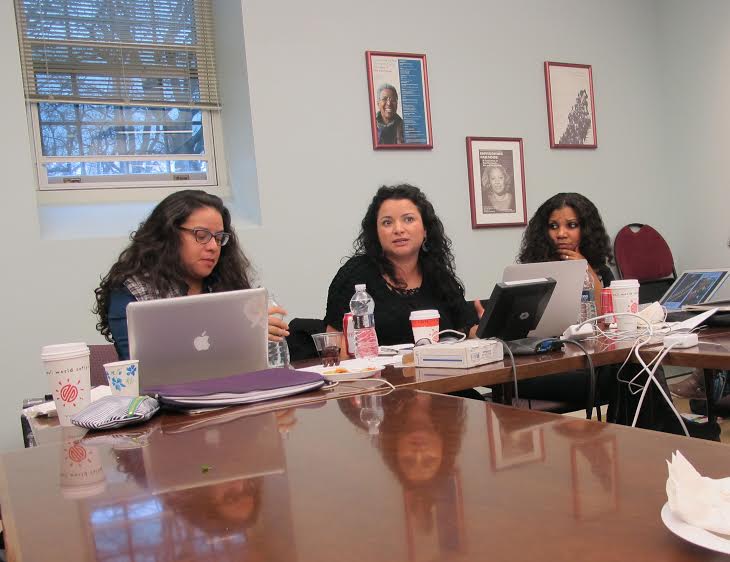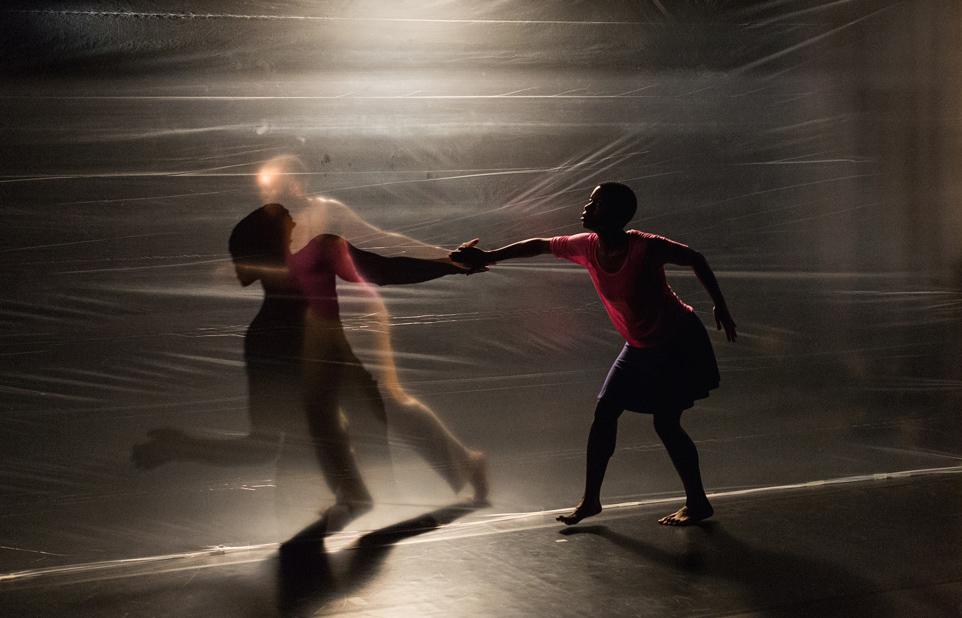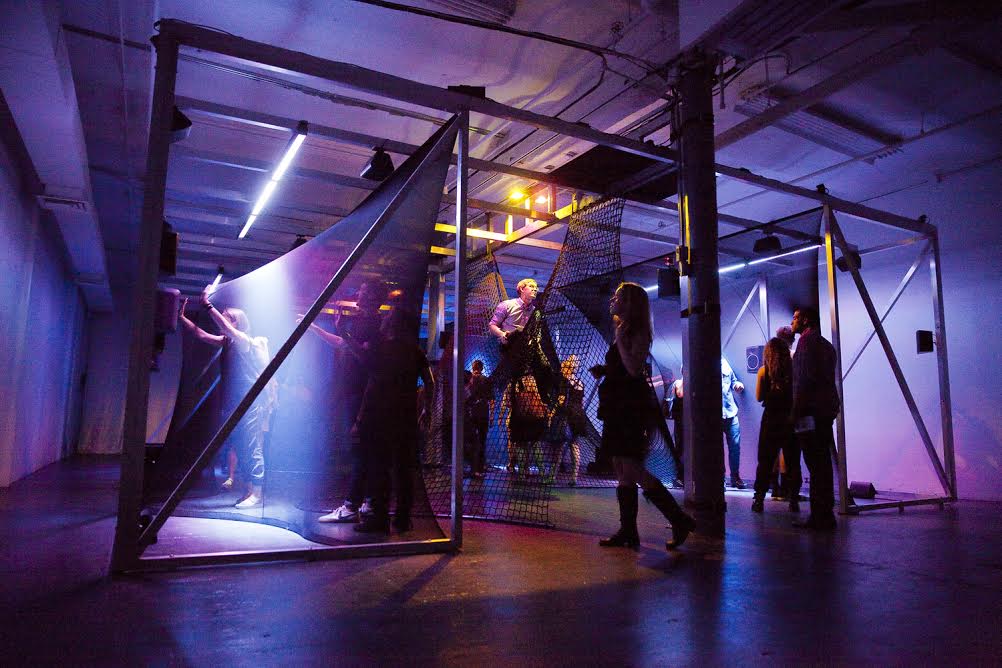The 2016 Creative Capital Awards – Meet our Program Consultants
We couldn’t be happier about the 46 projects in Emerging Fields, Literature and Performing Arts that were recommended for funding this year. Three Program Consultants, Kim Whitener (HERE Arts Center), Ethan Nosowsky (Graywolf Press) and Regine Basha (Basha Projects), worked with more than 100 colleagues in each field during the ten-month process, reviewing submissions at every stage. I’ve asked Kim, Ethan and Regine a few questions about what it was like to work with Creative Capital on the process.
Lisa Dent: Each of you has been working with us for over a year, can you believe it? Ethan, this is even your fourth time as our Literature Consultant! When I contacted you about the award round, what did you think it would be like? What surprised you?
Kim Whitener: I was really honored and honestly excited about spending time with all of you at Creative Capital, with my fellow consultants and panelists, and most importantly, through their applications, with the many hundreds of artists all over the country who are bursting with amazing ideas. The accrual of knowledge about the field and how artists are thinking and experimenting was enormous for me—even as long as I’ve been in the performing arts field, the sheer depth and scope of the proposed projects surprised me and brought me to new places and understandings. My other lead consultants and I were particularly struck by how much artists are taking on the role of being the voice of social activism in our culture—taking historical moments and reinterpreting them, and grappling with every societal issue with tremendous bravery.
Ethan Noswosky: Yes, I’ve been consulting for Creative Capital since the literature program was added ten years ago. At the time, neither I nor anyone from my neck of the literary woods really knew of anything quite like the mix of grant making and artist services that has become the hallmark of Creative Capital. In every grant year, the great pleasure for me is discovering the richness and depth of the field. It’s a blast seeing writers whose work you’re familiar with propose something new and thrillingly urgent, but what’s even better is becoming acquainted with writers you’ve only heard of, or getting introduced to writers you’ve never heard of at all. I wasn’t so much surprised at anything in particular, but I was confirmed in my sense that this is a very good moment for the literary arts, with a range of writers drawing on a range of traditions to produce really exciting work.
Regine Basha: I expected it to be quite challenging of course given the number of proposals, but I think that ample time was given to us to go over all the proposals in a fairly comfortable manner each time! In terms of the nature of the proposals, I think I expected way more ‘social practice’ types of proposals, but there were less than I had expected and more proposals from science-oriented projects.
Lisa: How did the submitted project proposals differ from what you normally see in your field? What were the themes or ideas that seemed particularly timely to you?
Kim: As I just alluded to, there were almost no projects that weren’t extremely timely. In one way or another the artists are doing deep cultural exploration—around issues of race, gender, identity; class war and economic insecurity; women in society and family histories; environmental issues; corporate responsibility and imperialism; and concerns with the alienation of technology/social media and an uncertain future. Kind of mind-blowing! It’s not that these issues haven’t always been addressed by artists in general and performing artists in this case—it’s just that I was so struck by how universal this exploration was. Perhaps it’s an assumption that artists have that this is what is expected of them, but very few are exploring “art for art’s sake” as the saying goes.
Ethan: Every year it seems that the submitted projects start clustering around a handful of subjects and themes. I think it can take writers longer to process and respond to current events than it does for artists in other disciplines. Up to ten years or more, I think, to gain the perspective and material that’s required to digest the moment. And yet writers, like anyone, are responsive to the times they live in. Issues of migration, race, and the besieged environment expressed themselves in sometimes sly and angular ways. We saw a number of projects that take on bilingualism or, more broadly—and sometimes very broadly—issues of translation.
Place seemed to be a concern for many artists—some who struggled with the place they might be from, and others who tried to imagine or inhabit landscapes and locales that are utterly unfamiliar to them. This year, and I can’t explain why, there were several fiction projects that wanted to tackle the representation of autistic or otherwise developmentally disabled people. Generally, it’s always gratifying to see writers finding the best possible form—and sometimes those forms are quite strange or new or boundary pushing—to express the subject matter at hand.
Regine: I would say they differ in their ambition and scale—for instance the length and term of production sometimes can last up to five years—which you do not find anywhere else. Also the nature of collaborations were expected to run much deeper than in other granting bodies (most likely because of the length of engagement).
Lisa: We ended up with some amazing projects this year. Which ones stand out for you?
Kim: That’s like asking me to choose between my children! I was so thrilled with the roster that we chose—every single project is testing form and content, engaging ideas in a singular way, and represents a unique moment in the artist’s career. I was very moved by them all. A couple of standouts: Okwui Okpokwasili’s Poor People’s TV Room, a visceral movement-theater/media project working with wonderful partners in Africa; Lei Liang’s Inheritance, a multi-media opera about the fateful history of a gun manufacturer; Robin Frohardt’s The Plastic Bag Store, an experiential object-theater piece tackling waste in our society… the list could go on.
Ethan: We have only six grantees in literature, and I’d like to say they all stand out! Latasha Diggs’s work is truly exciting—she’s a true artist, and her language is just ALIVE. Her new poetry project is ambitious and innovative, interrogating the way history is inevitably “translated.” Jesse Ball is a standout stylist, a novelist who always seems to push at the edges of the form, and this new novel promises to be his most personal and necessary yet. Percival Everett has built a substantial career as one of our most restlessly experimental writers, and this new project questions not only the authority of the narrator, which is getting to be an old question, but the authority of the book itself. Eileen Myles is similarly a veteran artist who finally seems to be getting her due. “My Travels” might look like a series of humble travel essays, but I think they covertly add up to an innovative autobiography.
We saw quite a lot of applicants collaging their work, to greater and lesser effect. But Dao Strom’s proposed Postwar Tablefruit employs images and text fragments and music to tell a story that is both fascinating on the level of memoir, and interdisciplinary in the best way. And last but not least, I was delighted that we were finally able to support a collaborative project in literature. Nelly Rosario, Macarena Hernandez, and Sheila Maldonado are drawing on the fotonovela tradition in desveladas to bring to life an ongoing conversation and correspondence they’ve been having about borders, migration, and identity.
Regine: I was especially intrigued and excited by some of the new technologies (the app to make music) as well as innovative gaming approaches coming from female designers!
Lisa: Do you recommend that artists apply in the future? Why?
Kim: Absolutely. I know it’s a lot of work. But apart from the obvious reason that the Creative Capital grant is one of the only individual artist grants around – it is so, so much more. The financial support is important, of course, but in a way it’s the least significant part of the Creative Capital award and model. The opportunity for an artist to build a long-term relationship with CC’s passionate and talented team and be mentored through the process of development and production, not to mention all of the support in building their capacity to thrive in the complex landscape of art-making these days, is completely unique and career-changing. I have heard so many artists who’ve received a grant say this. It’s a little heart-breaking to know that there are so many deserving artists and projects out there and so few resources – but it’s the exciting challenge we all have to keep building those resources so more can be served!
Ethan: The Creative Capital program is pretty unique in the way that it tries to engage with writers both financially and strategically to help them better realize the potential of their work. It’s not for everyone, but it’s an exceptional way to support writers doing work that might not get funded at all in a more traditional way. I think the most important thing is to apply when you’re ready and able to convey the urgency of something you’re working on. And while the writers who have been awarded grants this year are mostly mid-career or veteran artists, Creative Capital is also always eager to support young artists who have a strong sense of where they are and where they want to go.
Regine: Yes, I always have a slew of artists each year that I encourage to apply. I recognize that it is not for everyone, so I often consider this encouragement quite seriously. Artists need to be comfortable with the length of engagement and demand, but more and more I see how useful a process this is for so many artists. I was especially happy to see mid-career artists (apply). That allowed me to consider another level of artist who may benefit from the process as well. It seems that art production has entered a level of economics that is nearly equivalent to independent filmmaking so it’s very useful for the field itself to rise to the occasion and take this kind of production seriously and not as an occasional aberration.
Read more about the 2016 Creative Capital Artists and browse their work here.




